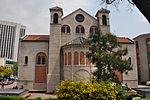Embassy of the United Kingdom, Seoul
Diplomatic missions in SeoulDiplomatic missions of the United KingdomForeign relations stubsJung District, SeoulSouth Korea–United Kingdom relations

The British Embassy in South Korea (Korean: 주한 영국 대사관) is the diplomatic mission of the United Kingdom to South Korea. The British Ambassador to South Korea is Colin Crooks, since March 2022.
Excerpt from the Wikipedia article Embassy of the United Kingdom, Seoul (License: CC BY-SA 3.0, Authors, Images).Embassy of the United Kingdom, Seoul
Sejong-daero 19-gil, Seoul
Geographical coordinates (GPS) Address Website External links Nearby Places Show on map
Geographical coordinates (GPS)
| Latitude | Longitude |
|---|---|
| N 37.567035277778 ° | E 126.97502305556 ° |
Address
주한영국대사관
Sejong-daero 19-gil 24
04519 Seoul
South Korea
Open on Google Maps








